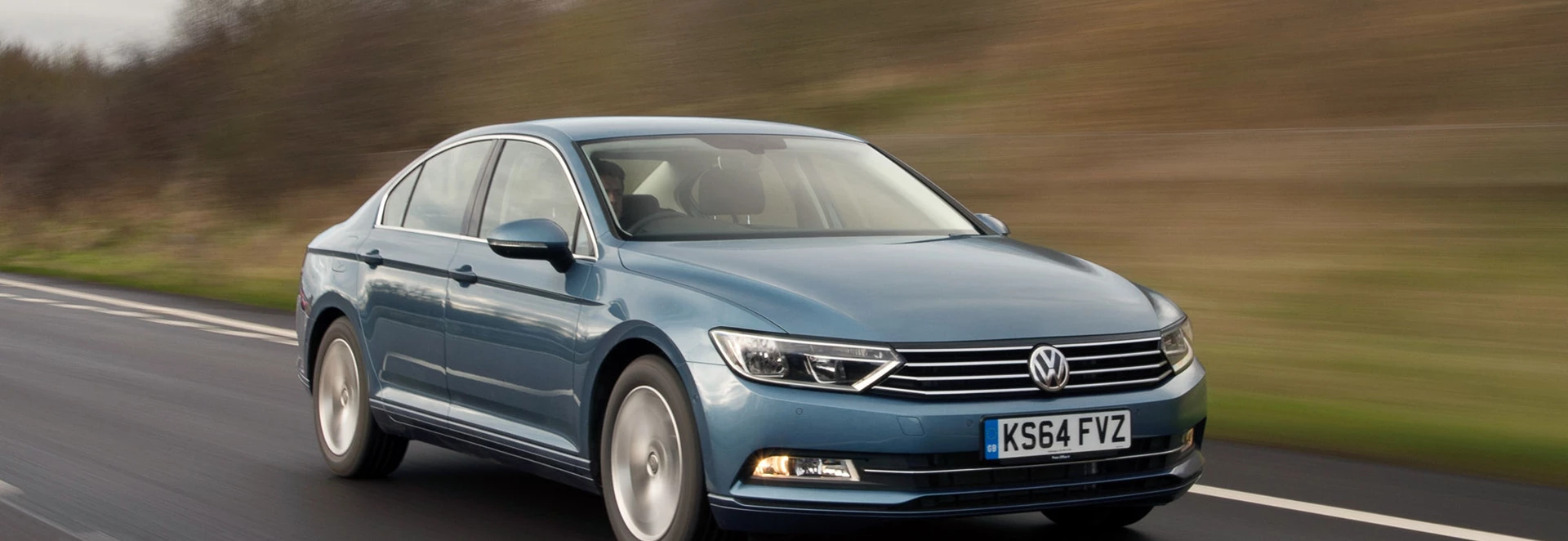Most people in the UK asked to name a mainstream large saloon car would probably mention the Ford Mondeo or Vauxhall Insignia long before they thought of the Volkswagen Passat. VW is hoping to change this with the new-for-2015 model. Based on the increasingly ubiquitous MQB platform, it's about the same size as the outgoing version but up to 85kg lighter, with more passenger room and a lot of new tech.
In this country, Passats are more popular with fleet buyers than private customers, in a four-to-one ratio, and since fleet buyers value low running costs there are no petrol engines in the new range. It's diesel or nothing.
There are also no hatchbacks, which may not go down well, but there is a choice of saloon and estate body styles. A high-economy, low-CO2 BlueMotion model and a semi-off-road Alltrack will join the range in mid-2015.
Performance
Power outputs from the various diesel engines range between 118bhp and 237bhp. The 118bhp 1.6-litre unit is fine for everyday motoring but not strong enough to answer urgent calls for hard acceleration effectively. The 237bhp 2.0-litre twin turbo BiTDI, available with four-wheel drive and seven-speed semi-automatic DSG gearbox, gives by far the best performance in the range. 0-62mph takes just 6.1 seconds, and if you're on a German autobahn you can go all the way up to 147mph.
The 187bhp single turbo 2.0-litre TDI is quite perky, but there's nothing wrong with the 148bhp version which Volkswagen expects will be the most popular engine in this country. The top speed and 0-62mph time are 146mph and 7.7 seconds respectively with DSG. Estate models are 0.2 seconds slower to 62mph.
Smooth gear changing is difficult in the manual cars we've driven so far, though this may be because they were all still quite new, with less than 1000 miles on the clock.
Ride and Handling
The handling is very safe and predictable, and there is no sense in normal motoring that either end ever comes close to losing grip.
The Passat doesn't like uneven British road surfaces. Apparently set up for much smoother German tarmac, it wobbles over the smallest bumps and feels much less composed than, say, a petrol-engined Mondeo with small wheels. Oddly, though, larger wheels and (relatively) low-profile tyre seem to suit the Passat well, making it more comfortable against all expectations. And estate models feel very much the same from the driving seat as the saloons do, even though the rear suspension must have been designed to cope with heavy loads. Even in the best case, however, the Passat does not ride as well as we believe it should. The handling is very safe and predictable, and there is no sense in normal motoring that either end ever comes close to losing grip. The BiTDI copes with its high power output very well and will tolerate a large burst of power in the middle of a tight corner, if you're in the mood for that sort of thing.
Interior and Equipment
This is the eighth Volkswagen model to bear the name Passat. The first was launched back in 1973.
The interior looks smart, if not particularly adventurous. A digital instrument display, similar to that used in the Audi TT and due to be introduced in 2015, will spruce up the appearance nicely. There's a general sense of quality, though as with the smaller Golf this is spoiled by the rotary controls for the air-conditioning, which do not feel as if they should be in a car costing within £10,000 of this one. Passenger space is outstanding, especially in the rear. Transporting four large adults in a Passat is very easy. Luggage space in the saloon has risen by 21 litres to 586 litres, though the boot opening is smaller than it might be because the rear window extends so far back, and objects that might fit in the boot itself can't be put through the gap. The capacity of the estate is 650 litres with the rear seats in place and 1,780 litres to roof level when they're folded down. All these figures beat those of the Mondeo and Insignia. There are five trim levels, called S, SE, SE Business, GT and R-Line. All have automatic post-collision braking, Driver Alert, DAB digital radio and Bluetooth connectivity. Pre-crash protection, adaptive cruise control and City Emergency Braking are optional on the S and standard on everything else. From SE Business upwards, the comprehensive Discover Navigation system is fitted as standard.
Cost
The 237bhp BiTDI has the highest CO2 emissions at 139g/km as a saloon and 140g/km in estate form and will cost £130 per year in VED.
Prices range from £22,215 to £37,035, with estates costing £1530 more than saloons. The 1.6-litre models, while not excitingly fast, have CO2 emissions of under 110g/km and therefore cost £20 per year in Vehicle Excise Duty, as does the 148bhp 2.0-litre with manual transmission. 1.6-litre TDIs with the DSG gearbox have a Benefit In Kind tax rate of 16% until April 2015, 18% for the next financial year and down to 17% in 2016. The forthcoming BlueMotion model will have combined fuel economy of 78mpg and 95g/km of CO2, so there will be no VED to pay and be 1% under the 1.6-litre DSGs in terms of BIK. The 237bhp BiTDI has the highest CO2 emissions at 139g/km as a saloon and 140g/km in estate form and will cost £130 per year in VED - a small matter compared with its list price of over £35,000.
Our Verdict
The new Passat is not a particularly interesting car, but it's a very competent one and will be easy to live with. Its best feature is the amount of room it has for passengers and luggage, its worst (which may not bother some people) the uncertain ride quality. It works well as a rival to the Mondeo and Insignia, but it's unlikely to outsell either as long as there is no hatchback version.




